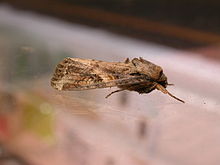Fall armyworm
| Fall armyworm | |
|---|---|

| |

| |
| Scientific classification | |
| Kingdom: | |
| Phylum: | |
| Class: | |
| Order: | |
| Family: | |
| Genus: | |
| Species: | S. frugiperda
|
| Binomial name | |
| Spodoptera frugiperda (J.E. Smith, 1797)
| |
The fall armyworm (Spodoptera frugiperda) is part of the order of Lepidoptera and is the larval (see caterpillar) life stage of a fall armyworm moth. It is regarded as a pest and can wreak havoc with crops if left to multiply. Its name is derived from its feeding habits. They will eat everything in an area, and once the food supply is exhausted, the entire "army" will move to the next available food source.
Description
The larvae are a dull yellow to gray with stripes running down the length of the body. The mature caterpillar is about 1.5 to 2 inches (51 mm) in length.[1]
Habitats
The fall armyworm is widely distributed in eastern and central North America and in South America; it cannot survive freezing temperatures.[2][3]

Feeding habits
The armyworm's diet consists mainly of grasses and small-grain crops. An infestation is hard to detect, as the caterpillars migrate to new feeding areas in the cool of the night. When the caterpillars near maturity, they can lay waste to an entire crop in a few days.
Infestations
In 1998, Illinois was hit hard by fall armyworms.[4]
Research use
S. frugiperda cells (Sf9 and Sf21 cell lines) are commonly used in biomedical research for the purpose of recombinant protein expression using insect-specific viruses called baculoviruses.
See also
- African armyworm (Spodoptera exempta) (Africa)
- Common armyworm or true armyworm (Mythimna unipuncta) (North and South America)
- Northern armyworm, Oriental armyworm or Rice ear-cutting caterpillar (Mythimna separata) (Asia)
References
- ^ Kathy L. Flanders, Donald M. Ball, Patricia P. Cobb. University of Alabama and Auburn University Extension Office. August 2011. Management of Fall Armyworm in Pastures and Hayfields
- ^ Murúa MG et al. (2009) Natural distribution of parasitoids of larvae of the fall armyworm, Spodoptera frugiperda, in Argentina Journal of Insect Science 9(20)
- ^ Meagher RL and Nagoshi RN (2004) Population dynamics and occurrence of Spodoptera frugiperda host strains in southern Florida Ecological Entomology 29(5): s 614–620
- ^ Mike Gray, University of Illinois Extension Office. July 10, 1998 Fall Armyworms: Many Southern Illinois Cornfields Are Infested
External links
- fall armyworm on the UF / IFAS Featured Creatures Web site
